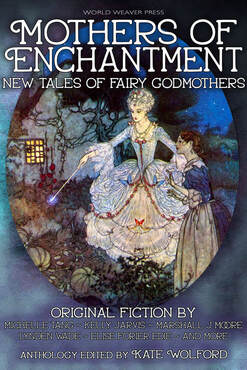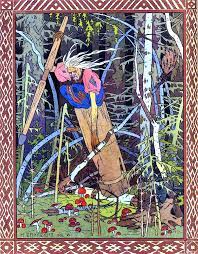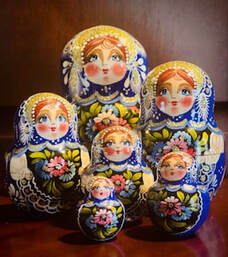 Guest Blog by Kelly Jarvis Every girl dreams of having a fairy godmother. But what happens when your fairy godmother is a witch? This is the question lurking behind my story for the Mothers of Enchantment: New Tales of Fairy Godmothers anthology. “A Story of Soil and Stardust” blends elements from traditional Cinderella and Vasilisa the Beautiful tales, casting Baba Yaga, the terrifying witch of Slavic folklore, in the fairy godmother role. I first learned about Baba Yaga through the anthology Skull and Pestle: New Tales of Baba Yaga. Described as a ferocious old woman with a hooked nose and long, bony legs, Baba Yaga can be found living deep in the woods in a broken-down hut that runs around on chicken feet. She flies through the air in a mortar and pestle, has a trio of horsemen to do her evil bidding, and satisfies her voracious appetite by devouring the flesh of children, adding their skulls and bones to the grisly fence that surrounds her forest property.  But, when we look beneath Baba Yaga’s frightening surface, we find so much more than a cannibalistic witch. She is a crafty crone, a wise woman, and an earth mother. Described as both a donor and a villain, Baba Yaga is just as likely to help the mortals she encounters as she is to eat them, and her insatiable hunger stands in bold opposition to the rules and restrictions imposed by civilized societies. Her name, which differs slightly within the Slavic languages, may reveal her softer side. “Baba” usually translates to “grandmother” or “old woman”, while “Yaga” may be a diminutive form of the name “Jadwiga”, a Slavic variation of the Germanic name “Hedwig”. Hedwig is also the name of the Catholic patron saint of orphans (Hedwig of Andechs), and although an exact connection between the saint and Baba Yaga can’t be drawn, the similarity of their names made me wonder how Baba Yaga might interact with the orphaned protagonists of Cinderella and Vasilisa tales. It was from this wondering that my witchy fairy godmother was born. Once Baba Yaga entered my story, the details of the narrative fell into place. The setting moved to the harsh northern forest. The pages filled themselves with warm baked breads, steaming bowls of porridge, grilled sausages, and thick pieces of gravied beef, offerings to satisfy Baba Yaga’s deep hunger. The doll, a symbol central to the Vasilisa tale, became a Matryoshka Doll, a set of wooden nesting dolls placed one inside the other. As a child, I delighted in twisting these dolls open to find smaller dolls inside, amazed by the number of unseen secrets the outermost doll could hold within her.  Stories are a lot like Matryoshka Dolls; they invite us to twist them open and find the treasures hidden within. Their smallest elements stand as reflections of the whole, and it can take time and patience to stack the pieces together in meaningful order. If a Matryoshka Doll can hold endless versions of herself within her, then perhaps Baba Yaga can do the same, and we need only to twist open her stories to see the secret fragments that make her who she is. Fairy godmothers come in all shapes and sizes, and it may be possible that a gruesome witch can be a blessing to an orphaned child desperate to find her way in a hostile world. You will have to read my story to find out. Kelly Jarvis (she/her) is the Special Projects Writer for Enchanted Conversation: A Fairy Tale Magazine. Her work has appeared in Eternal Haunted Summer, Mermaids Monthly, and Blue Heron Review. When not writing, she teaches classes in writing, literature, and fairy tale at Central Connecticut State University.
0 Comments
Your comment will be posted after it is approved.
Leave a Reply. |
World Weaver PressPublishing fantasy, paranormal, and science fiction. Archives
February 2024
|
- Home
-
Books
-
All Books
>
- Beyond the Glass Slipper
- Bite Somebody
- Bite Somebody Else
- Black Pearl Dreaming
- Cassandra Complex
- Causality Loop
- Clockwork, Curses, and Coal
- Continuum
- Corvidae
- Cursed: Wickedly Fun Stories
- Dream Eater
- Equus
- Fae
- Falling of the Moon
- Far Orbit
- Far Orbit Apogee
- Fractured Days
- Frozen Fairy Tales
- Glass and Gardens: Solarpunk Summers
- Glass and Gardens: Solarpunk Winters
- Grandmother Paradox
- Grimm, Grit, and Gasoline
- Haunted Housewives
- Heir to the Lamp
- He Sees You When He's Creepin': Tales of Krampus
- Into the Moonless Night
- Jack Jetstark's Intergalactic Freakshow
- King of Ash and Bones (ebook)
- Krampusnacht
- Last Dream of Her Mortal Soul
- Meddlers of Moonshine
- Mothers of Enchantment
- Mrs Claus
- Multispecies Cities
- Murder in the Generative Kitchen
- Recognize Fascism
- Scarecrow
- Sirens
- Shards of History
- Shattered Fates
- Skull and Pestle
- Solarpunk (Translation)
- Solarpunk Creatures
- Solomon's Bell
- SonofaWitch!
- Speculative Story Bites
- Trenchcoats, Towers, and Trolls
- Weredog Whisperer
- Wolves and Witches
- Anthologies and Collections
- Novels
- Novellas
- Fairy Tale
- Fantasy
- Romance
- Science Fiction
- Urban/Contemporary Fantasy
- Young Adult SFF
-
All Books
>
- Blog
- About
- Contact
- Press / Publicity
- Newsletter Signup
- Privacy Policy
- Store

 RSS Feed
RSS Feed